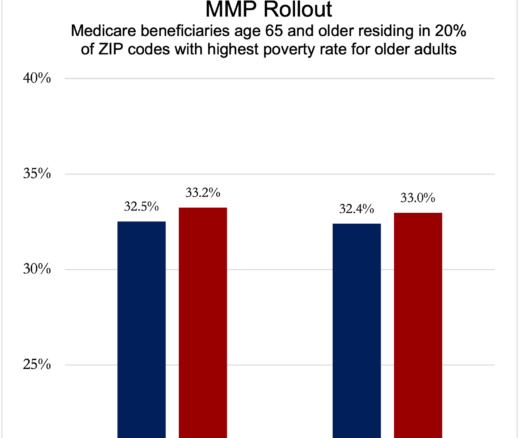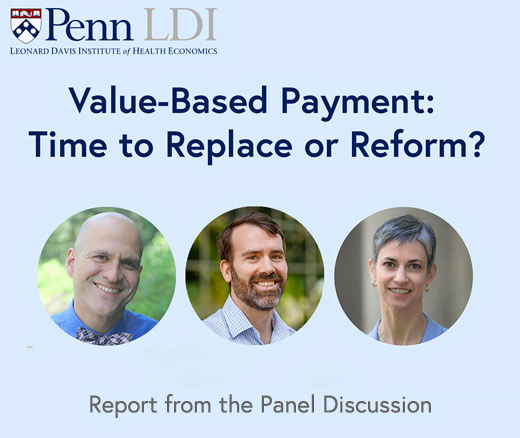
Integrated Care Plans Didn’t Boost Medicaid Enrollment for the Poorest Seniors
Chart of the Day: Medicare-Medicaid Plans—Created to Streamline Care for Dually Eligible Individuals—Failed to Increase Medicaid Participation in High-Poverty Communities
Blog Post

How can providers, policymakers, and health care leaders ensure that patients are having good health care experiences? Research from Wharton LDI Fellows points toward one solution: sharing patients’ narratives about their care experiences with clinical staff to inform health care operations. Narratives are stories about care experiences in patients’ own words.
Dr. Ingrid Nembhard, Wharton Professor of Health Care Management and LDI Senior Fellow, alongside Associate Fellow Sasmira Matta and colleagues, found that organizations that often share patient narratives with their staff receive higher patient experience scores.
In clinical settings, a patient’s experiences provide integral information for understanding the quality of their interactions with health systems and providers. Patient experience scores, provided by the Consumer Assessment of Healthcare Providers and Systems (CAHPS) surveys from the Agency for Healthcare Research and Quality and the Centers for Medicare and Medicaid Services, have become popular metrics for quantifying how patients perceive their experiences of care.
Patient experience scores are important for improving health care delivery, as they help indicate the degree to which treatment is patient-centered.
The investigators studied survey data from 5,751 patients across nine adult primary care clinics that adopted measures of patient experience derived from the CAHPS Clinician and Group Survey. The survey included a series of open-ended questions that elicited patient narratives about their experiences; questions such as, “What do you like best about our office? What do you like least about our office? Is there anything else that you would like to share about your experience?” Investigators also reviewed patient narrative responses to five questions from the CAHPS Narrative Item Set (NIS). They then assessed the correlation between clinical staff’s narrative exposure and their clinic’s patient experience score performance.
Study findings revealed that sharing narratives was linked to better patient experience scores across the clinics, although this depended on the specific domain of patient experience measured and the staff’s confidence in their knowledge of their patients and practice.
According to Dr. Nembhard, “Patient narratives provide additional insights about organizational functioning. In their narratives, patients often elaborate on why they chose their closed-ended responses, provide information about aspects of their experiences not captured by closed-ended questions in patient surveys, and often offer their own creative ideas for how patient care experiences can be improved. Organizations that use this additional insight to guide their care practices and improvement efforts should deliver more patient-centered care, and thus have better patient experience survey scores. Of course, as our study shows, that linkage also depends on organizational attributes.”
For example, clinical staff that considered themselves more confident in their own knowledge had higher rates of using patients’ narratives, which correlated to higher scores for operational measures of patient experience—measures that capture the structural components of a health system that shape a patient’s perceptions. However, findings also showed lower scores for more confident staff for relational measures, which are measures that capture the quality of interpersonal components of health care delivery, when they had higher rates of narrative exposure. This highlights the need to further address how a patient’s narrative interacts with staff confidence in the future.
In the realm of clinical medicine, acknowledging experience through narrative has become popular over the past few decades. Lessons from the fields of narrative medicine and ethics show that narrative competence is a model for humane and effective care and policymaking—the ability to recognize, listen to, interpret, and act on the stories of others. Although patients’ narratives provide a voice to their experiences, the power of narrative has been difficult to interpret in research settings, creating gaps between research and clinical practice. Nembhard and colleagues research shows that it is possible to bridge this gap.
The importance of narrative and measures of patient experience are hard to overstate. The incorporation of narrative-informed practices in medicine and policymaking will make lived experiences central, not incidental, to deliberations in practice.
For example, regulators are making a concerted effort to augment the experiences of consumers during critical moments in their lives, including those of patients when receiving clinical care. This is evidenced by the 2023 announcement of nine Life Experience Projects by the Office of Management and Budget, which are federal efforts to put people at the center of all government-supported endeavors. The Life Experience Projects were part of the 2021 Executive Order that called for more accountability of government leaders for how they are perceived by the public during times of critical need and crisis.
Contemporary efforts for social justice will require medicine, policy, and law to become humanized and democratized, which the incorporation of narrative use into practice can help facilitate. By giving patients a voice in reporting how they perceive their care, providers, policymakers, and health care leaders can help inspire more substantive change that uplifts the positions of those who are impacted by their decision-making the most.
The study, “Learning from Patients: The Impact of Using Patients’ Narratives on Patient Experience Scores,” was published on January 3, 2024, in Health Care Management Review. Authors include Ingrid M. Nembhard, Sasmira Matta, Dale Shaller, Yuna S. H. Lee, Rachel Grob, and Mark Schlesinger.


Chart of the Day: Medicare-Medicaid Plans—Created to Streamline Care for Dually Eligible Individuals—Failed to Increase Medicaid Participation in High-Poverty Communities

Penn LDI Debates the Pros and Cons of Payment Reform

One of the Authors, Penn’s Kevin B. Johnson, Explains the Principles It Sets Out

Six Lessons the U.S. Can Learn from Europe About Protecting Health Data Linkages

Moving from Fee-for-Service to Risk-Based Contracts Hasn’t Dramatically Changed Patient Care, Raising Questions About How to Make These Models More Effective

Equitably Improving Care for Hospitalized Kids Who Experience Cardiac Arrest Requires Hospital-Level Changes, LDI Fellows Say